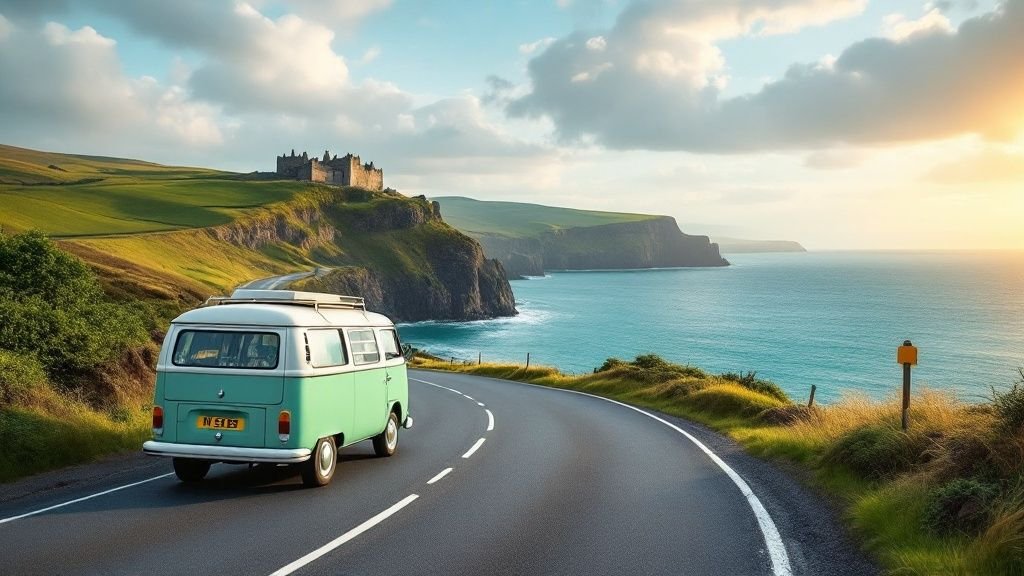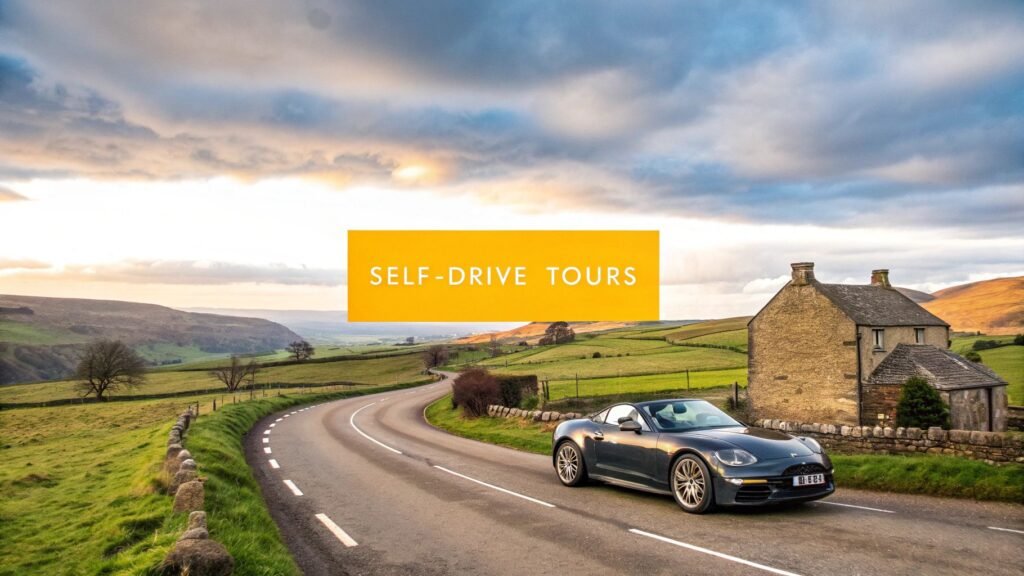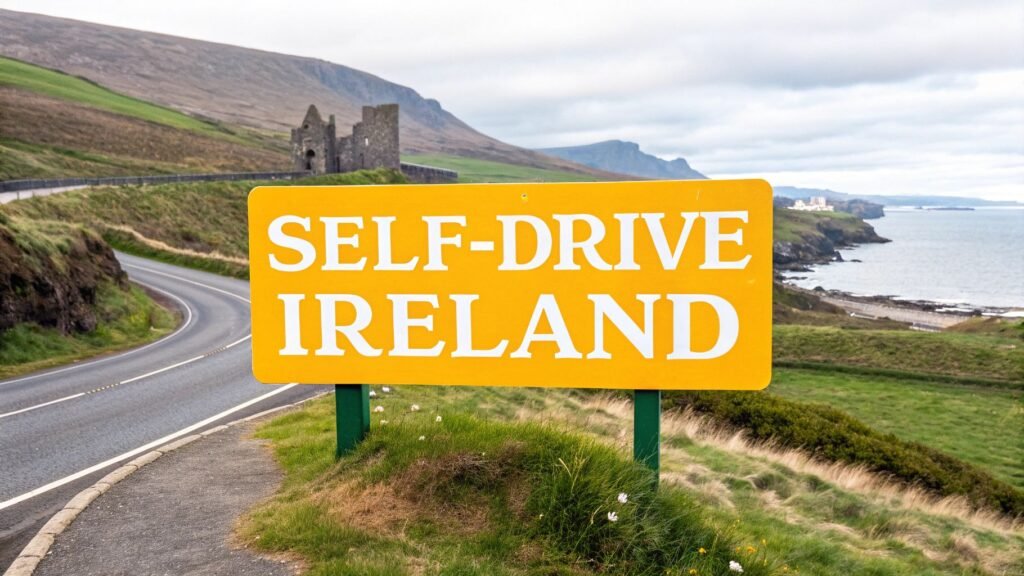A classic road trip through Wales is a journey of contrasts. You’ll find yourself navigating between ancient castles that whisper tales of old, along dramatic coastlines pounded by the sea, and through the wild, untamed beauty of its national parks. A good route typically kicks off in the lively south, winds its way up the breathtaking west coast, and finds its peak among the rugged mountains of Snowdonia. It’s the perfect mix of culture, adventure, and scenery that stays with you long after you've returned home.
Charting Your Welsh Adventure
So, you're planning a road trip through the heart of Cymru (Wales). Excellent choice. This is a land where every turn in the road reveals another postcard-perfect view, from the golden sands of the Pembrokeshire coast to the misty peaks of Eryri (Snowdonia). Hitting the road on a self-drive tour is, without a doubt, the best way to soak it all in, giving you the freedom to linger where you want and discover things on your own terms.
This guide is built to give you a solid, day-by-day plan that you can either follow to the letter or use as a springboard for your own adventure. We'll hit the must-see spots, but I'll also point you towards a few hidden gems that make a trip through Wales truly special. You’ll get practical advice on everything from driving times to what local food you absolutely have to try.
The Route In Numbers
Here’s a quick snapshot of what a typical 5-day route through Wales looks like. It’s a great starting point for figuring out your own timings and budget.
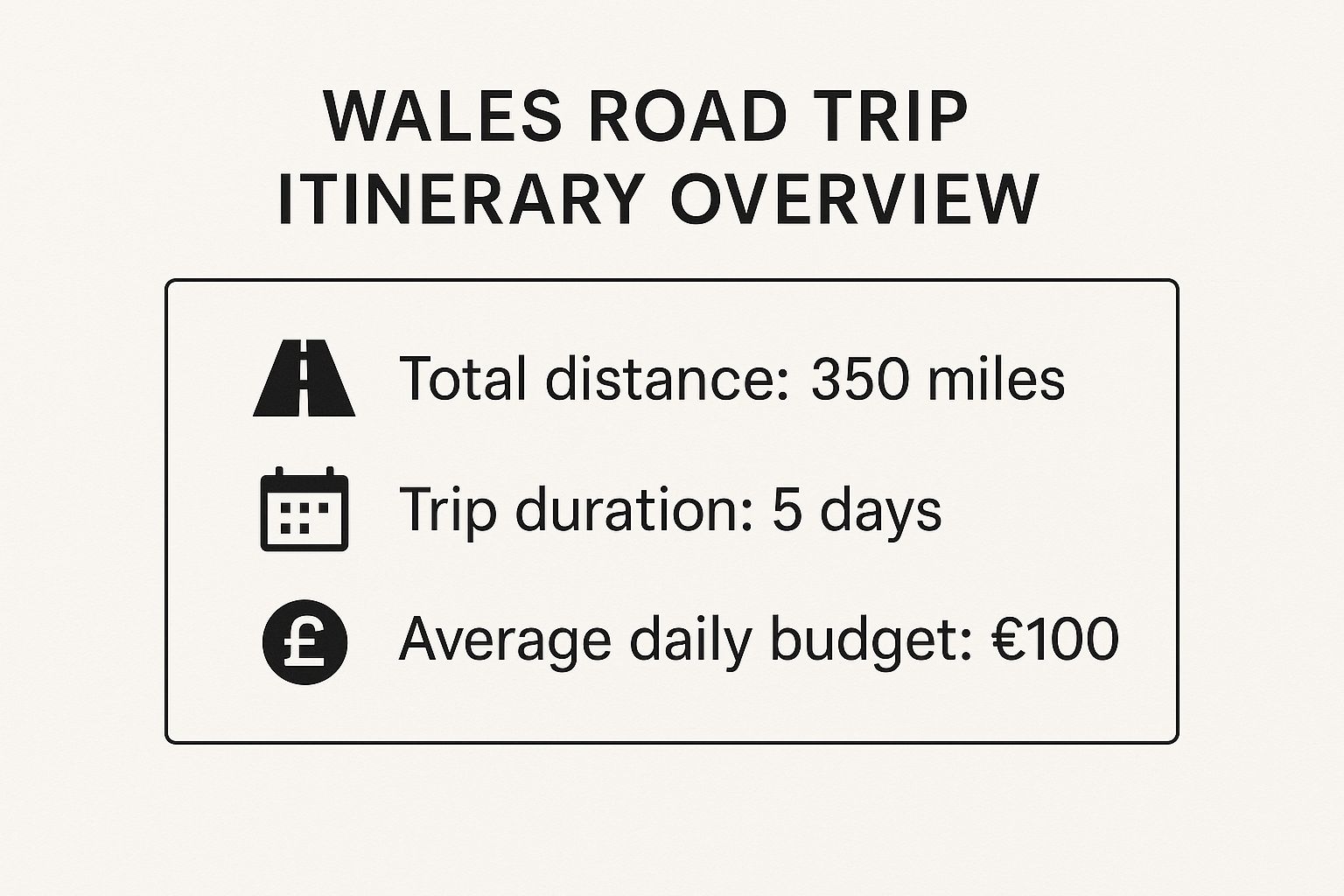
These numbers show that you can pack a huge amount into just a few days without breaking the bank. It's a manageable but incredibly rewarding trip.
7-Day Wales Itinerary At A Glance
For those with a bit more time, a 7-day trip allows you to really sink your teeth into what Wales has to offer. This itinerary is a classic for a reason—it covers a fantastic range of landscapes and experiences, from coastal towns to mountain passes.
| Day | Main Destination | Key Highlights |
|---|---|---|
| 1 | Cardiff | Cardiff Castle, Cardiff Bay, vibrant city centre |
| 2 | Pembrokeshire Coast | Tenby, St Davids Cathedral, coastal path walks |
| 3 | Mid Wales | Aberystwyth, Devil's Bridge Falls, Elan Valley |
| 4 | Snowdonia (Eryri) National Park | Drive through the park, visit Betws-y-Coed |
| 5 | Snowdonia (Eryri) National Park | Climb Yr Wyddfa (Snowdon), explore Llanberis |
| 6 | Anglesey | South Stack Lighthouse, Beaumaris Castle |
| 7 | North Wales Coast | Conwy Castle, Llandudno, return journey |
This route gives you a fantastic overview of the country. A real highlight is the Gower Peninsula, a paradise for nature lovers with its 10 nature reserves and 24 Wildlife Trust reserves. It’s an essential stop for anyone wanting to experience the raw, natural beauty of Wales. You can dive deeper into trip ideas on our other guides to Wales.
What To Expect From This Guide
I've broken this guide down into manageable days and regions, making sure you have all the info you need for a smooth and memorable journey. Here’s a quick look at what’s coming up:
- Detailed Daily Itineraries: Clear routes covering South, Mid, and North Wales.
- Accommodation Suggestions: My top picks, from seaside cottages to cosy B&Bs.
- Must-See Attractions: The castles, national parks, beaches, and villages you can't miss.
- Insider Driving Tips: Real-world advice for tackling narrow country lanes and scenic mountain passes.
Speaking of activities, getting out for a walk is non-negotiable here. The landscapes are just begging to be explored on foot. For some brilliant ideas, especially if you're travelling in the autumn, check out these 7 Best Fall Hiking Destinations in the UK.
Days 1 to 3: Exploring South Wales Wonders
We're kicking off this Welsh road trip in the south, a region that perfectly blends vibrant city life with some of Britain’s most dramatic coastline. These first three days are all about balance—a taste of history in Cardiff, the raw beauty of the Gower Peninsula, and the charming seaside towns of Pembrokeshire. It's the perfect start to a proper Welsh adventure.
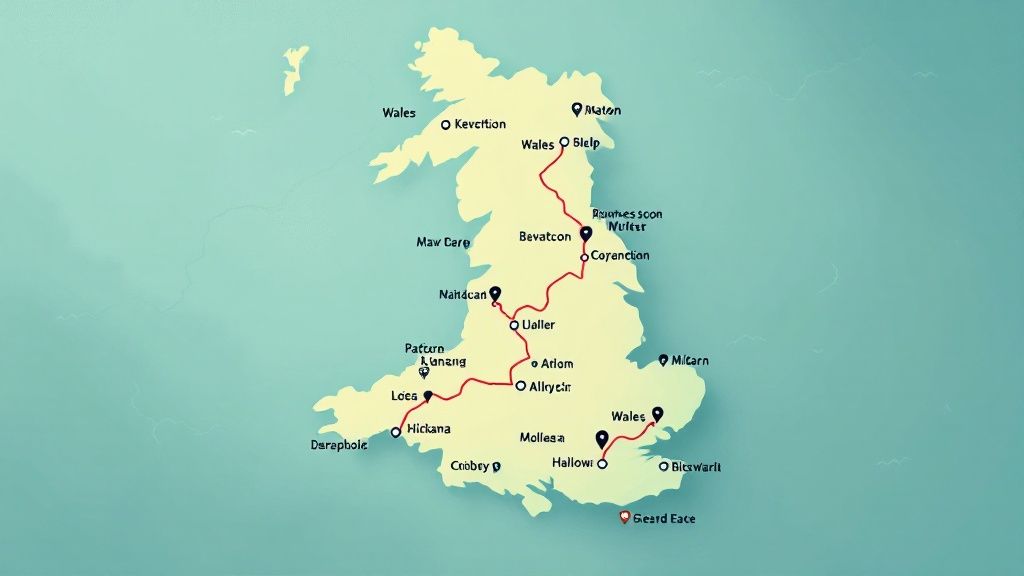
Day 1: Cardiff Capital Exploration
You'll arrive in Cardiff, Wales's energetic capital. It’s a brilliant city to ease into your trip because it’s so easy to get around. Your first port of call has to be the magnificent Cardiff Castle. With over 2,000 years of history, its walls tell tales from Roman times right through to its extravagant Victorian Gothic revival.
Once you’ve had your fill of history, take a wander through the city centre’s Victorian arcades for some unique shopping. Afterwards, make your way down to Cardiff Bay. This regenerated waterfront is buzzing with activity and is home to the striking Wales Millennium Centre and the Senedd (the Welsh Parliament).
For dinner, you're spoilt for choice, with everything from traditional pubs to contemporary Welsh cuisine. It’s a great introduction to the local culture before you hit the open road.
Overnight Stay Suggestion: I'd recommend staying in or near the city centre to make the most of your time. You’ll find everything from boutique hotels to cosy, welcoming guesthouses.
Day 2: The Glorious Gower Peninsula
Today, we leave the city buzz behind and head west to the Gower Peninsula, which holds the title of the UK’s first-ever designated Area of Outstanding Natural Beauty. The drive from Cardiff is a straightforward 1 hour and 15 minutes (roughly 45 miles), leaving you with a full day to explore its incredible coastline.
Your main destination here is the world-famous Rhossili Bay. It’s consistently voted one of Britain’s best beaches, and once you see its three-mile stretch of golden sand, you’ll understand why. Park up at the National Trust car park and take the cliff-top path—the views are simply jaw-dropping.
Insider Tip: If you're feeling adventurous, check the tide times for the walk out to Worm's Head. This dramatic, serpent-shaped tidal island at the end of the bay offers a challenging but unforgettable hike. Just be sure you know when you need to be back!
From Rhossili, it's worth making your way to Three Cliffs Bay. As the name suggests, this beach is famous for its three pointed limestone peaks and is a dream for any photographer. Reaching it involves a scenic walk from the car park, which really adds to the sense of discovery.
South Wales Coastal Path Highlights:
- Langland to Caswell Bay: A gentle, paved walk perfect for families, offering classic seaside views without too much effort.
- Rhossili to Worm's Head: A more rugged, iconic hike that needs careful planning around the tides but rewards you with spectacular scenery.
- Oxwich Bay: A huge, sheltered beach that’s ideal for a relaxing stroll or even trying some watersports.
For a classic pub lunch, you can't go wrong with The King's Head Inn in Llangennith. It's a local favourite, known for its hearty meals and properly welcoming atmosphere. If you're looking for more structured adventures in this part of the country, a guided taste of South England and Wales tour can offer some fantastic inspiration.
Overnight Stay Suggestion: Find a charming B&B or a coastal cottage in The Mumbles. It’s a lively Victorian seaside village that acts as the perfect gateway to the Gower.
Day 3: Pembrokeshire's Picturesque Towns
On day three, we're venturing further west into Pembrokeshire, a journey of about 1 hour and 30 minutes (around 60 miles) from the Gower. Your first stop is the ridiculously pretty harbour town of Tenby.
With its pastel-coloured houses huddled together, medieval town walls, and three stunning sandy beaches, Tenby is a pure delight. Spend your time wandering its cobbled streets, grabbing an ice cream, and just soaking up the views from Castle Hill.
From Tenby, it’s a short 30-minute drive to another Pembrokeshire gem, but this one holds a very special title. Welcome to St Davids, Britain’s smallest city. It gets its city status from the magnificent St Davids Cathedral, a breathtaking piece of architecture nestled in a hollow.
The ruins of the Bishop's Palace right next door are just as impressive and well worth exploring. The "city" itself is a tiny, charming collection of independent shops, galleries, and pubs.
Must-Do Activities in St Davids:
- Explore the Cathedral: Really take your time here. The intricate details and peaceful atmosphere of this historic site are something special.
- Walk a Section of the Pembrokeshire Coast Path: The coastline around St Davids is particularly dramatic. The walk towards Caerfai Bay offers incredible views.
- Take a Boat Trip: If you have the time, a boat trip around Ramsey Island to spot seals and seabirds is an experience you won't forget.
Overnight Stay Suggestion: I’d stay in or around St Davids to fully appreciate its unique atmosphere. There are plenty of guesthouses and small hotels that offer a warm Welsh welcome, getting you ready for the next leg of your journey north.
Days 4 to 5: Driving The Coastal Way into Mid Wales
Leaving the beautiful little towns of Pembrokeshire behind, you’re now heading into the middle leg of the journey, which features one of Wales’ most celebrated drives. This is where the landscape truly opens up, revealing the vast, sweeping curve of Cardigan Bay. Days 4 and 5 are all about embracing the journey itself, following the iconic Coastal Way before venturing inland to the wild heart of Mid Wales.
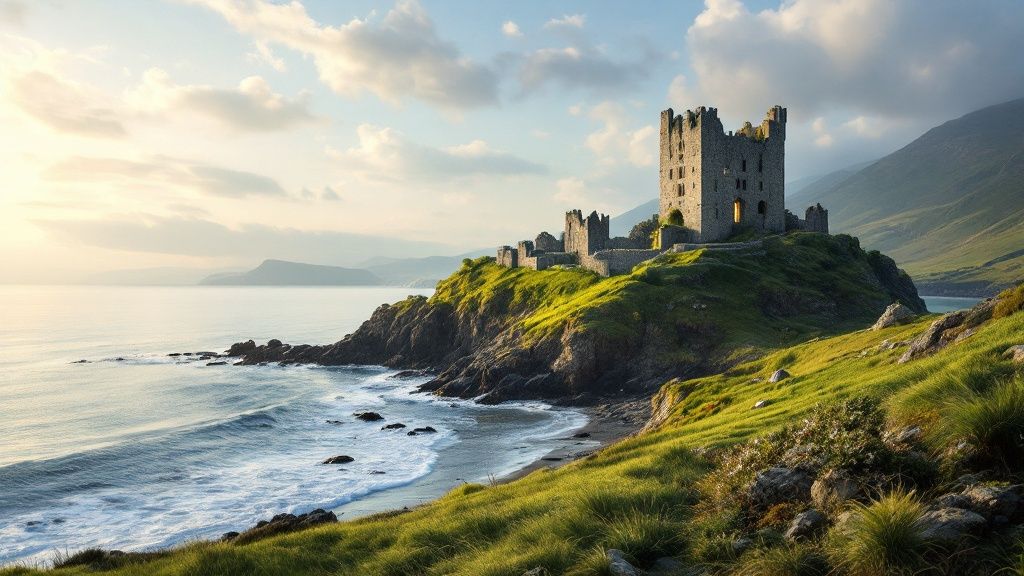
This part of the trip is a study in contrasts. You'll go from salty sea air and dolphin-spotting opportunities to the serene, reservoir-dotted landscapes of the Cambrian Mountains. Get ready for incredible views, quaint harbour towns, and a profound sense of getting away from it all.
Day 4: Following The Coastal Way North
Today is all about the drive. Heading north from St Davids, you’ll pick up The Coastal Way, a route that consistently pops up on lists of the best road trips on the planet. This spectacular 180-mile (290 km) journey shows off the very best of Cardigan Bay, linking one picturesque town to the next with rugged cliffs and wide sandy beaches. Its fame is well-deserved, as you'll soon see.
Your first must-see stop is the delightful harbour town of Aberaeron. It's famous for its elegant Regency-style houses painted in a vibrant rainbow of colours, making it a perfect spot to stretch your legs. The whole town was actually designed by architect Edward Haycock back in the 1800s, giving it a unique, unified charm you won’t find anywhere else.
From Aberaeron, it's just a short hop to New Quay, another beautiful harbour town with a special claim to fame. It has strong links to the poet Dylan Thomas and just so happens to be one of the best places in the UK to spot bottlenose dolphins.
Top Things to Do in New Quay:
- Take a Dolphin Spotting Boat Trip: This is a must. Several operators run trips right from the harbour, and your chances of seeing the resident dolphin pod are surprisingly high.
- Walk the Dylan Thomas Trail: Follow the trail around town to discover the places that are said to have inspired his famous work, 'Under Milk Wood'.
- Grab a Honey Ice Cream: New Quay is famous for its honey ice cream. It's a local delicacy and the perfect treat on a sunny afternoon.
The drive itself offers countless chances to pull over at designated viewpoints. Don’t rush this bit; the secret coves and dramatic headlands are what make this part of your Wales itinerary so memorable. You can explore more fantastic driving adventures and other travel destinations on our site at https://btours.com/destinations/.
Overnight Stay Suggestion: Aberystwyth is a great place to stop for the night. It's a historic university town with a lively promenade, a funicular railway that climbs Constitution Hill for panoramic views, and the romantic ruins of Aberystwyth Castle.
Day 5: Into The Cambrian Mountains
After a day of coastal splendour, Day 5 takes you inland for something completely different but just as breathtaking. You’re heading into the Cambrian Mountains, a remote and rugged area often called the 'desert of Wales' because of its sparse population and vast, wild landscapes.
The drive from Aberystwyth to the Elan Valley only takes about an hour, but the change in scenery is instant and dramatic. The roads get quieter, flanked by rolling hills, dense forests, and open moorland.
Your main destination today is the Elan Valley, a stunning network of Victorian-built dams and reservoirs. This incredible feat of engineering was built over a century ago to supply water to Birmingham, but in doing so, created a landscape of serene beauty. It’s now a haven for wildlife and walkers.
Insider Tip: Start your visit at the Elan Valley Visitor Centre. They have excellent maps and can point you to the best walking or cycling routes depending on how much time you have. The drive around the reservoirs is a circular route of about 20 miles, with plenty of places to park up and just soak in the view.
The sheer scale of the dams—especially Caban Coch, Garreg Ddu, and Pen y Garreg—is awe-inspiring. If you're lucky enough to visit after heavy rainfall, you might see them overflowing, which creates the most spectacular man-made waterfalls.
Accommodation Ideas for Mid Wales:
- Countryside B&Bs: Experience classic Welsh hospitality in a traditional bed and breakfast, often with incredible views right from your window.
- Farm Stays: For a truly authentic experience, look into staying on a working farm. It’s a fantastic way to connect with the rural heart of Wales.
- Cosy Inns: Many of the small towns in the region, like Rhayader, have historic inns offering comfortable rooms and hearty pub grub.
This day is a peaceful, reflective counterpoint to the coastal excitement of the past few days. The quiet grandeur of the Cambrian Mountains will prepare you perfectly for the final, dramatic leg of your journey: the mighty mountains of North Wales.
Days 6 to 7: Conquering North Wales and Snowdonia
Get ready for the grand finale. The last leg of your Welsh road trip is a true showstopper, taking you into the dramatic, majestic landscapes of North Wales. These final two days are all about the epic mountains of Snowdonia National Park (Eryri) and the formidable castles that guard its coastline.
This is where the scenery gets cranked up to eleven. Towering peaks replace rolling hills, and ancient fortresses dominate the skyline. We’ll cover everything from tackling Wales's highest mountain to exploring a whimsical Italian-style village, making sure your journey ends on an unforgettable high.
Day 6: Adventures in Snowdonia National Park
Welcome to Eryri, a land of raw, rugged beauty that sprawls across a staggering 823 square miles. Day 6 is your chance to dive right in, with plenty of options to suit every energy level. For many, the main event is reaching the summit of Yr Wyddfa (Snowdon), the highest peak in both Wales and England.
If you're hiking for the first time, the Llanberis Path is your most straightforward bet. It’s a well-trodden trail that follows the route of the mountain railway, making it one of the more gradual ascents. Don't let that fool you, though—it’s still a challenging six-hour round trip that demands proper walking boots and a healthy respect for the notoriously changeable weather.
For a less strenuous but equally spectacular way to the top, the Snowdon Mountain Railway is a fantastic choice. This historic rack-and-pinion railway has been chugging its way to the summit since 1896, offering jaw-dropping panoramic views without breaking a sweat.
Insider Tip: Whether you plan to hike or take the train, you absolutely must book ahead. Parking at Pen-y-Pass (the starting point for other popular routes like the Pyg Track) has to be pre-booked, often well in advance. For the railway, tickets can sell out weeks, or even months, ahead during peak season. Don't leave it to chance.
Beyond the mountain itself, Snowdonia is an adventure playground:
- Zip World Penrhyn Quarry: Fancy flying over a quarry lake at over 100 mph? This is home to Velocity 2, the fastest zip line in the world. It’s a serious adrenaline rush.
- Betws-y-Coed: Often called the 'Gateway to Snowdonia', this enchanting village is packed with outdoor shops, cosy cafés, and picturesque river walks. It’s the perfect place to refuel and relax.
- Llyn Padarn: A stunning glacially-formed lake in Llanberis, perfect for a bit of kayaking, paddleboarding, or just a peaceful walk along its shores.
Overnight Stay Suggestion: Base yourself in either Llanberis or Betws-y-Coed. Llanberis puts you right at the foot of Snowdon, which is ideal for an early start. Betws-y-Coed has more of a charming village atmosphere with great pubs and restaurants.
Day 7: Castles and Coastal Charm
Your final day is a journey through history, exploring some of the most impressive fortresses in Europe and a truly one-of-a-kind coastal village. From the heart of Snowdonia, you’ll head towards the coast, where King Edward I’s formidable "Iron Ring" of castles still stands guard.
First up is the magnificent Caernarfon Castle. This UNESCO World Heritage site is an absolute brute of a fortress, with its unique polygonal towers and imposing, colour-banded walls. Its sheer scale is breathtaking, and its historic connection to the investiture of the Prince of Wales makes it a cornerstone of Welsh history.
From there, it’s a short drive along the coast to Conwy, another UNESCO gem. Conwy Castle is exceptionally well-preserved and feels like you’ve stepped straight into a medieval storybook. The town itself is just as magical, completely encircled by its original 13th-century walls. You can actually walk along the top for incredible views of the castle, the estuary, and the hills beyond.
After your deep dive into medieval history, it's time for a complete change of pace. Head south to the village of Portmeirion, the wonderfully eccentric creation of architect Sir Clough Williams-Ellis. It’s a slice of the Italian Riviera, unexpectedly nestled on the Welsh coast.
What to see in Portmeirion:
- The Central Piazza: Take a moment to admire the colourful facades, classical colonnade, and ornate fountains. It truly feels like you’ve been transported to Italy.
- The Gwyllt Woodlands: Escape into the miles of walking trails that wind through subtropical forests, discovering hidden follies and stunning coastal viewpoints along the way.
- The Hotel Portmeirion: Even if you're not staying, pop in for a drink or afternoon tea on the terrace. The view over the Dwyryd Estuary is simply sublime.
Portmeirion is a wonderfully surreal and beautiful way to end your exploration of North Wales. It captures the imagination and offers a peaceful contrast to the rugged mountains and imposing castles you’ve seen. This final day perfectly encapsulates the spirit of Wales—a land of dramatic history, stunning landscapes, and completely unexpected charm. A fitting conclusion to your epic Welsh road trip.
Essential Tips for Driving in Wales
Before you set off on your grand Welsh road trip, it’s worth spending a little time getting to grips with what it’s actually like to drive here. Getting behind the wheel in Wales is a massive part of the adventure, taking you from modern motorways to ancient, single-track lanes that feel like they’ve been carved right into the scenery. Understanding the unique rhythm of these roads is the key to a smooth, stress-free journey.
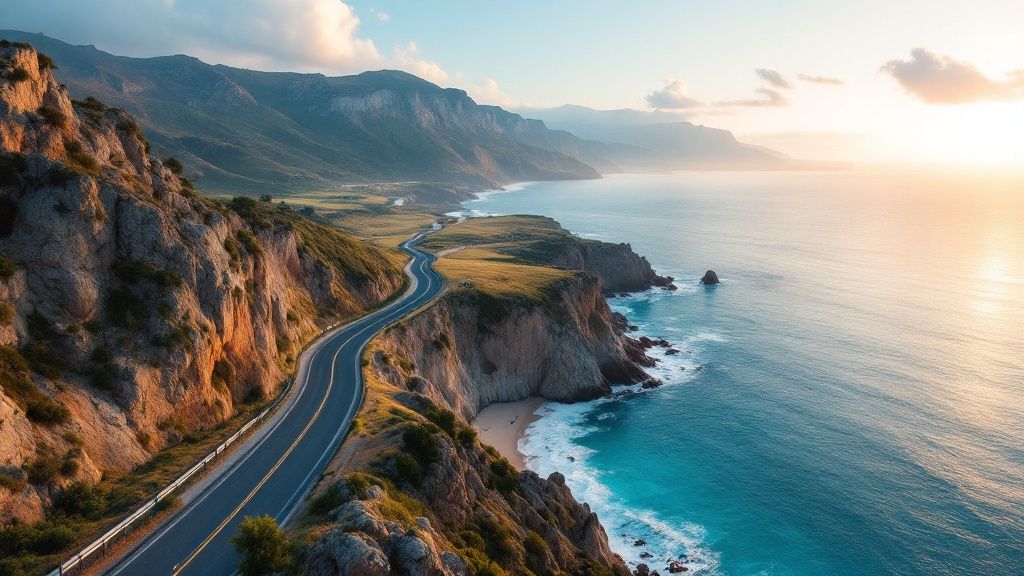
One thing you’ll notice is that journeys here often feel shorter than they look on the map. In fact, the average car journey in Wales is only about 9 miles. This makes the country perfect for those relaxed, scenic drives where it’s more about soaking in the view than racing to the next stop.
Navigating Narrow Country Lanes
Let's be honest, the most memorable parts of any Welsh road trip are usually found down a narrow, rural lane. These single-track roads, often flanked by high hedgerows, can feel a bit daunting at first. But once you get the hang of the local etiquette, they’re a joy to drive.
The whole system relies on passing places – small pull-outs cut into the verge. Here’s how to handle them like a local:
- Look ahead: Keep your eyes peeled for oncoming traffic. The general rule is that whoever is closer to a passing place should be the one to pull in and wait.
- Give a thank-you wave: A quick wave or a flash of your headlights is the universal sign for "cheers" when another driver pulls over for you. It’s a small courtesy that goes a long way.
- Don’t park in them: This is a big one. Passing places are only for passing. Never, ever use them to park, even if it's just for a quick photo.
Best Time of Year for a Welsh Road Trip
Picking the right time to visit can make or break your trip. Every season in Wales has its own personality, bringing different charms and challenges for drivers.
Our Recommendation: We’ve found the sweet spot to be the shoulder seasons – late spring (May-June) and early autumn (September-October). You usually get decent weather, the roads are quieter than in summer, and the scenery is at its best, whether it's covered in spring wildflowers or blazing with autumn colours.
Summer (July-August) is glorious when the sun shines, but it also brings the crowds. Expect more traffic, especially on those popular coastal roads and mountain passes. Winter can be absolutely magical, but you need to be ready for potentially icy conditions, particularly in high-altitude areas like Eryri (Snowdonia) and the Bannau Brycheiniog (Brecon Beacons).
Budgeting for Your Journey
A little bit of budget planning can take a lot of the stress out of your trip. Costs can swing wildly, of course, but here’s a rough daily guide for a comfortable, mid-range road trip to get you started.
| Item | Estimated Daily Cost (per person) | Notes |
|---|---|---|
| Fuel | £20 – £30 | Based on typical daily driving distances. |
| Accommodation | £40 – £70 | Thinking of B&Bs or budget-friendly hotels. |
| Food | £30 – £50 | A mix of hearty pub meals and some self-catering. |
| Activities | £15 – £25 | Covering entry fees for castles and other attractions. |
It's also smart to have a plan for the unexpected. Knowing who to call in an emergency, like local emergency car locksmith services in South Wales, offers real peace of mind. And if you’d rather someone else handle all the logistics, our https://btours.com/self-drive-tours/ are a great option, with pre-planned routes and support along the way.
Your Wales Road Trip Questions Answered
So, you’re planning a road trip around Wales. Fantastic choice! But before you hit the road, a few practical questions always pop up. Getting these sorted now means you can just relax and soak up the scenery later.
Let's dive into some of the most common queries I hear from travellers, so you can feel fully prepared for your Welsh adventure.
What’s the Best Car for Driving in Wales?
Forget the massive 4×4. Honestly, a small to medium-sized car is your best friend here. Something like a Ford Fiesta or a VW Golf is perfect. You'll thank me when you're navigating those charmingly narrow country lanes or squeezing into a tight parking spot in a tiny village.
Unless you're planning on some serious off-roading (which isn't part of this itinerary!), a standard hire car will handle everything from the M4 motorway to the winding mountain passes of Snowdonia with no problem at all. The most important thing is choosing a car you feel comfortable and confident behind the wheel of.
Is It Okay to Wild Camp on My Road Trip?
This one's a bit of a grey area. Technically, wild camping isn't legal in Wales without the landowner's permission. It’s particularly frowned upon in the National Parks like Snowdonia (Eryri) and the Brecon Beacons (Bannau Brycheiniog) because of the fragile environment.
My advice? For a completely stress-free trip, book designated campsites. Wales has an incredible selection, from basic farmer's fields with million-dollar views to fully-equipped sites with hot showers and Wi-Fi. It’s the best way to be a responsible traveller and support local communities.
Will I Have Mobile Phone Signal Everywhere?
In a word: no. Once you get into the beautifully remote parts of Snowdonia or the Cambrian Mountains, your phone signal will likely disappear. You’ll be fine in the cities and larger towns, but don’t count on it for navigating in the sticks.
Here’s my non-negotiable tip: Before you even leave home, download offline maps of Wales onto your phone using Google Maps or another app. It’s an absolute lifesaver. Trust me, doing this one simple thing will save you from a world of stress and wrong turns.
How Much Should I Budget for Petrol?
Fuel will be one of your biggest costs, there's no getting around it. For a week-long journey following a route like this, I'd suggest budgeting somewhere in the region of £150 to £200. Of course, this really depends on your car's fuel efficiency and what the prices are like at the pump when you're travelling.
A couple of things to keep in mind to save a few quid:
- Always try to fill up at the big supermarkets in towns. Their prices are almost always cheaper than the small, independent stations out in the countryside.
- Don't let your tank get too low in rural areas. Petrol stations can be few and far between, and you don’t want to get caught out.
A little bit of planning here goes a long way, leaving you to focus on the drive itself.
At BTOURS, we live and breathe this stuff. We craft seamless self-drive adventures that let you discover the real magic of Wales, all at your own pace. See what we're all about and explore our expertly planned itineraries at https://www.btours.com.

